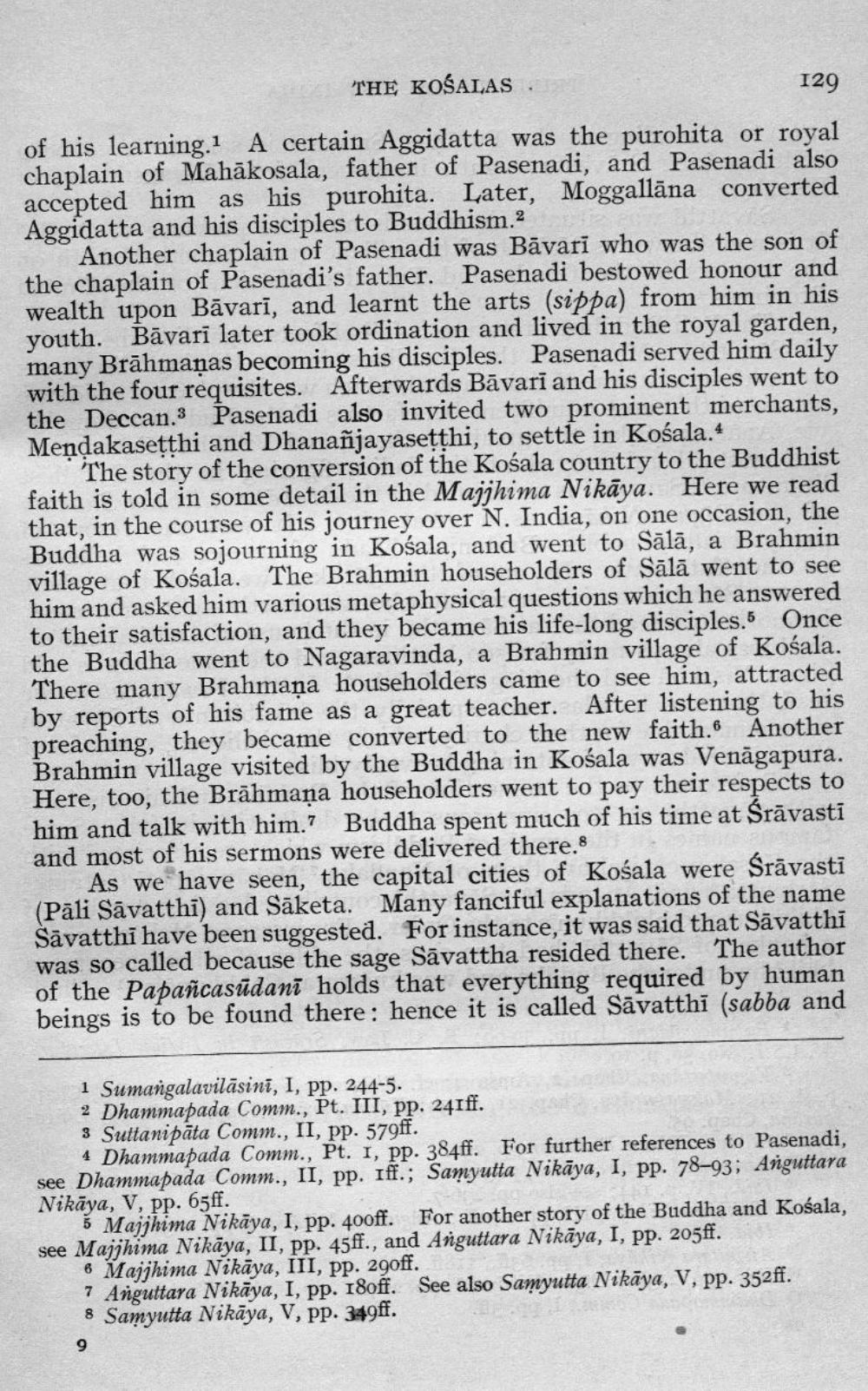________________
THE KOŠALAS
129
of his learning.1 A certain Aggidatta was the purohita or royal chaplain of Mahākosala, father of Pasenadi, and Pasenadi also accepted him as his purohita. Later, Moggallāna converted Aggidatta and his disciples to Buddhism.2
Another chaplain of Pasenadi was Bāvarī who was the son of the chaplain of Pasenadi's father. Pasenadi bestowed honour and wealth upon Bāvarī, and learnt the arts (sippa) from him in his youth. Bāvari later took ordination and lived in the royal garden, many Brāhmaṇas becoming his disciples. Pasenadi served him daily with the four requisites. Afterwards Bāvari and his disciples went to the Deccan.3 Pasenadi also invited two prominent merchants, Mendakasetthi and Dhanañjayasetthi, to settle in Kośala.4
The story of the conversion of the Kośala country to the Buddhist faith is told in some detail in the Majjhima Nikāya. Here we read that, in the course of his journey over N. India, on one occasion, the Buddha was sojourning in Kośala, and went to Sālā, a Brahmin village of Kosala. The Brahmin householders of Sālā went to see him and asked him various metaphysical questions which he answered to their satisfaction, and they became his life-long disciples. Once the Buddha went to Nagaravinda, a Brahmin village of Kośala. There many Brahmaņa householders came to see him, attracted by reports of his fame as a great teacher. After listening to his preaching, they became converted to the new faith. Another Brahmin village visited by the Buddha in Kośala was Venāgapura. Here, too, the Brāhmaṇa householders went to pay their respects to him and talk with him.? Buddha spent much of his time at Śrāvasti and most of his sermons were delivered there.
As we have seen, the capital cities of Kośala were Śrāvasti (Pāli Sāvatthi) and Sāketa. Many fanciful explanations of the name Sāvatthi have been suggested. For instance, it was said that Săvatthi was so called because the sage Sāvattha resided there. The author of the Papañcasūdanī holds that everything required by human beings is to be found there: hence it is called Sāvatthi (sabba and
1 Sumangalavilāsini, I, pp. 244-5. 2 Dhammapada Comm., Pt. III, pp. 241ff. 3 Suttanipāta Comm., II, pp. 579ff.
4 Dhammapada Comm., Pt. 1, pp. 384ff. For further references to Pasenadi, see Dhammapada Comm., II, pp. Iff.; Samyutta Nikāya, I, pp. 78-93; Anguttara Nikāya, V, pp. 65ff.
5 Majjhima Nikāya, I, pp. 400ff. For another story of the Buddha and Kośala, see Majjhima Nikāya, II, pp. 45ff., and Anguttara Nikāya, I, pp. 205ff.
8 Majjhima Nikaya, III, pp. 29of.. 7 Anguttara Nikāya, I, pp. I8of. See also Samyutta Nikāya, V, pp. 352ff. 8 Samyutta Nikāya, V, PP. 349ff.




